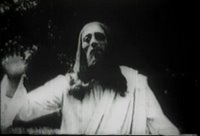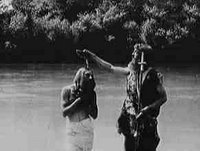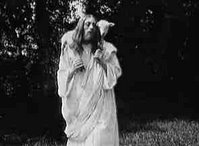 A while back someone very kindly let me know that the silent, Italian Jesus film Christus was available in Italy as part of a 2 DVD set along with Maria Figlia Del Suo Figlio. They also point out this page which has a brief overview of the film, and a whopping 78 stills from the film. That page is in Italian, but there's a translated version of courtesy of Google.
A while back someone very kindly let me know that the silent, Italian Jesus film Christus was available in Italy as part of a 2 DVD set along with Maria Figlia Del Suo Figlio. They also point out this page which has a brief overview of the film, and a whopping 78 stills from the film. That page is in Italian, but there's a translated version of courtesy of Google.There were a number of things about this page that caught my eye. Firstly it's obvious from the photos that this was a lavish production in it's day and the accompanying text notes that over 2000 actors and extras were used. Just look, for example, at the numbers of people accompanying the wise men.
 Secondly if the ratio of stills to runtime is anything like accurate then around 40% of the film's runtime is devoted to the nativity sequences. The length of the film is given in metres, which means that its length in minutes depends on the projector's frames per second. Manfred Tiemann's notes on over 650 Jesus films records it as 60 minutes, but at 2279m it's likely to have been somewhat longer.
Secondly if the ratio of stills to runtime is anything like accurate then around 40% of the film's runtime is devoted to the nativity sequences. The length of the film is given in metres, which means that its length in minutes depends on the projector's frames per second. Manfred Tiemann's notes on over 650 Jesus films records it as 60 minutes, but at 2279m it's likely to have been somewhat longer.One that that particularly jumped out was that the face of the actor playing Jesus was familiar, but it wasn't until I reached the stills of the resurrection and ascension that I realised where I knew him from. Back in May, I blogged about a film released either in 1916 or in 1919 under the title Jesus of Nazareth. It turned out that the film was actually a re-release of From the Manger to the Cross with resurrection and ascension scenes from two different films tagged on. And this film is one of the bits of footage used. What's even more interesting about this is the way that Christus borrows ideas from From the Manger to the Cross, such as the use of the Sphinx and the Pyramids, the boy Jesus forming a cross shape with hi shadow etc. There are also obvious borrows from other Jesus films of the era, such as the appearance of the angels to the shepherds which is straight out of The Life and Passion of Jesus Christ .
 Silent Jesus films were obviously fairly restricted in the amount of dialogue they could convey, and as a result most of them focussed more on Jesus the miracle worker, rather than Jesus the teacher. This film, however, may be an exception. The only discernable miracle displayed is the walking on water. It's possible that some of the crowd scenes relate to miracles in the temple or something, but otherwise there is very little of the miraculous in this film. This is perhaps not surprising. As noted above around 40% of the film deals with the nativity and a further 45% deals with the last supper onwards leaving only around 15% to do with Jesus's life and ministry. We do however see him teaching in at least two different contexts.
Silent Jesus films were obviously fairly restricted in the amount of dialogue they could convey, and as a result most of them focussed more on Jesus the miracle worker, rather than Jesus the teacher. This film, however, may be an exception. The only discernable miracle displayed is the walking on water. It's possible that some of the crowd scenes relate to miracles in the temple or something, but otherwise there is very little of the miraculous in this film. This is perhaps not surprising. As noted above around 40% of the film deals with the nativity and a further 45% deals with the last supper onwards leaving only around 15% to do with Jesus's life and ministry. We do however see him teaching in at least two different contexts.Assuming the order of these stills is correct a scene guide for the film looks as follows:
Annunciation - (Matt 1:18-25 / Luke 1:26-1:38)This is all very provisional based on the stills on the site, but it appears that Jesus delivers the Sermon on the Mount before his baptism which also occurs after his temptation.
Census - (Luke 2:1-2)
Birth - (Luke 2:3-8)
Shepherds - (Luke 2:9-15)
Wise Men - (Matt 2:1-12)
Flight to Egypt - (Matt 2:13-15)
Boy Jesus - (Luke 2:41-52)
Sermon on the Mount - (Matt 5-7)
Temptation (?) - (Mark 1:12-13)
Baptism - (Mark 1:9-11)
Rejection at Nazareth ? - (Mark 6:1-5)
Mary Magdalene ?
Jesus's Feet Anointed - (Mark 14:3-9)
Walking on Water - (Mark 6:45-52)
Journey to Jerusalem - (Mark 10:32)
Triumphal Entry - (Mark 11:1-10)
Last Supper - (Mark 14:22-31)
Plot to Kill Jesus - (Mark 14:1-2)
Gethsemane - (Mark 14:32-52)
Trial - (Mark 14:53-64)
Beating - (Mark 14:65)
Pilate, Jesus and the Crowds - (John 18:28-40)
Flogging - (John 19:1-3)
Pilate condemns Jesus - (John 19:4-16)
Via Dolorosa - (Mark 15:20-22)
Crucifixion - (Mark 15:22-39)
Burial - (Mark 15:40-47)
The Guard at the Tomb – (Matt 27:62-66)
Risen Jesus Before Disciples – (Luke 24:36-41)
Ascension - (Luke 24:50-53)
 Visually there are a few interesting shots. Firstly, one shot has Jesus carrying a sheep on his shoulders. It's rare to see such an image these days except on super-kitschy items, but I'm under the impression that it was much more common. Rather than a reference to a direct incident, it is of course a literalisation of Jesus's metaphorical use of a good shepherd. I also like the shot of Joseph's dream prior to the Flight to Egypt. Certainly mundane by today's standards, but I've not seen such an early use of that technique prior to this. There is also one with someone who looks like they are meant to be a prostitute, who may or may not be Mary Magdalene. Nothing specific to say other than that I'm particularly drawn to the composition of this scene. To me, at least, it seems fairly advanced for its day (although I'm certainly no expert in such things).
Visually there are a few interesting shots. Firstly, one shot has Jesus carrying a sheep on his shoulders. It's rare to see such an image these days except on super-kitschy items, but I'm under the impression that it was much more common. Rather than a reference to a direct incident, it is of course a literalisation of Jesus's metaphorical use of a good shepherd. I also like the shot of Joseph's dream prior to the Flight to Egypt. Certainly mundane by today's standards, but I've not seen such an early use of that technique prior to this. There is also one with someone who looks like they are meant to be a prostitute, who may or may not be Mary Magdalene. Nothing specific to say other than that I'm particularly drawn to the composition of this scene. To me, at least, it seems fairly advanced for its day (although I'm certainly no expert in such things).Finally, it does appear that some of this footage uses a different actor to play Jesus. Either that or the actor playing him (Alberto Pasquali) looks very different from certain angles.
No comments:
Post a Comment